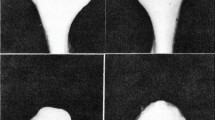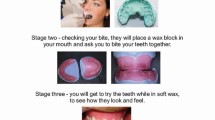Abstract
Cranial movement disorders are a common neurological problem. These disorders can be limited to the cranial muscles alone or manifest as part of a more generalized movement disorder. Cranial movement disorders can originate from the highest (motor cortex) to the lowest (cranial nerve and muscle) levels of the motor system. Owing to the lack of diagnostic tests and biomarkers for these disorders, their differential diagnosis can be difficult even for the experienced neurologist. Advances have, however, been made in the identification and treatment of these conditions, and most can be managed effectively with appropriate knowledge of the diagnostic signs and effective treatments. Here, we review the clinical features, pathophysiologies and therapies of the main movement disorders that affect the face, jaw, tongue and palate.
Key Points
-
Cranial movement disorders can be specific to the facial muscles or part of a generalized movement disorder
-
Cranial movement disorders can be generated by peripheral or central mechanisms
-
Neurophysiological and neuroimaging studies provide important insight into the pathophysiology of these disorders
-
The differential diagnosis of cranial movement disorders is made mainly on the basis of clinical characteristics, although neurophysiological and neuroimaging studies can also be of help
-
Treatment of the underlying disorder is mandatory when cranial movement disorders are part of a generalized disease
-
Botulinum neurotoxin is an effective symptomatic treatment in most focal cranial movement disorders
This is a preview of subscription content, access via your institution
Access options
Subscribe to this journal
Receive 12 print issues and online access
$209.00 per year
only $17.42 per issue
Buy this article
- Purchase on Springer Link
- Instant access to full article PDF
Prices may be subject to local taxes which are calculated during checkout

Similar content being viewed by others
References
Marsden CD (1976) Blepharospasm–oromandibular dystonia (Brueghel's syndrome): a variant of adult-onset dystonia? J Neurol Neurosurg Psychiatry 39: 1204–1209
Berardelli A et al. (1985) Pathophysiology of blepharospasm and oromandibular dystonia. Brain 108: 593–608
Hallett M (2002) Blepharospasm: recent advances. Neurology 59: 1306–1312
Aramideh M et al. (1994) Abnormal eye movements in blepharospasm and involuntary levator palpebrae inhibition: clinical and pathophysiological considerations. Brain 117: 1457–1474
Martino D et al. (2005) Relationship between eye symptoms and blepharospasm: a multicenter case-control study. Mov Disord 20: 1564–1570
Defazio G et al. (2004) Epidemiology of primary dystonia. Lancet Neurol 3: 673–678
Defazio G et al. (2007) Do primary adult-onset focal dystonias share aetiological factors? Brain 130: 1183–1193
Kimber TE and Thompson PD (2000) Increased blink rates in advanced Parkinson's disease: a form of off period dystonia. Mov Disord 15: 982–985
Burn DJ and Lees AJ (2001) Progressive supranuclear palsy: where are we now? Lancet Neurol 1: 359–369
Tolosa E and Compta Y (2006) Dystonia in Parkinson's disease. J Neurol 25 (Suppl 7): VII/7–VII/13
Berardelli A et al. (1998) The pathophysiology of primary dystonia. Brain 121: 1195–1212
Muller J et al. (2007) Auditory startle reaction in primary blepharospasm. Mov Disord 22: 268–272
Currà A et al. (2000) Shortened cortical silent period in facial muscles of patients with cranial dystonia. Neurology 54: 130–135
Quartarone A et al. (2008) Abnormal plasticity of sensorimotor circuits extends beyond the affected body part in focal dystonia. J Neurol Neurosurg Psychiatry 79: 985–990
Fiorio M et al. (2008) Tactile temporal discrimination in patients with blepharospasm. J Neurol Neurosurg Psychiatry 79: 796–798
Etgen T et al. (2006) Bilateral grey-matter increase in the putamen in primary blepharospasm. J Neurol Neurosurg Psychiatry 77: 1017–1020
Obermann M et al. (2007) Morphometric changes of sensorimotor structures in focal dystonia. Mov Disord 22: 1117–1123
Fabbrini G et al. (2008) Diffusion tensor imaging in patients with primary cervical dystonia and blepharospasm. Eur J Neurol 15: 185–189
Perlmutter JS et al. (1997) Decreased 18F spiperone binding in putamen in idiopathic focal dystonia. J Neurosci 17: 843–850
Hutchinson M et al. (2000) The metabolic topography of essential blepharospasm: a focal dystonia with general implications. Neurology 55: 673–677
Feiwell RJ et al. (1999) Diminished regional cerebral blood flow response to vibration in patients with blepharospasm. Neurology 52: 291–297
Dresel C et al. (2006) Silent event-related fMRI reveals deficient somatosensory activation in orofacial dystonia. Brain 129: 36–46
Stamey W and Jankovic J (2007) The other Babinski sign in hemifacial spasm. Neurology 69: 402–404
Jankovic J (2004) Botulinum toxin in clinical practice. J Neurol Neurosurg Psychiatry 75: 951–957
Simpson DM et al. (2008) Assessment: botulinum neurotoxin for the treatment of movement disorders (an evidence based review). Neurology 70: 1699–1706
Georgescu D et al. (2008) Upper eyelid myectomy in blepharospasm with associated apraxia of lid opening. Am J Ophthalmol 145: 541–547
Boghen D (1997) Apraxia of lid opening: a review. Neurology 48: 1491–1494
Defazio G et al. (1998) Isolated so-called apraxia of eyelid opening: report of 10 cases and a review of the literature. Eur Neurol 39: 204–210
Forget R et al. (2002) Botulinum toxin improves lid opening delays in blepharospasm associated apraxia of eyelid opening. Neurology 58: 1843–1846
Golbe LI et al. (1989) Eyelid movement abnormalities in progressive supranuclear palsy. Mov Disord 4: 297–302
Brewer GJ and Yuzbasiyan-Gurkan V (1992) Wilson's disease. Medicine 71: 139–164
Chinnery PF et al. (2007) Clinical features and natural history of neuroferritinopathy caused by the FTLI 460InsA mutation. Brain 130: 110–119
Dressler D and Benecke R (2005) Diagnosis and management of acute dystonic reactions. J Neurol 252: 1299–1306
Tolosa E (1993) Drug induced dyskinesia. In Parkinson's Disease and Movement Disorders, edn 2, 375–397 (Eds Jankovic J and Tolosa E) Baltimore: Lippincott Williams & Wilkins
Kane JM and Smith JM (1982) Tardive dyskinesia: prevalence and risk factors, 1959 to 1979. Arch Gen Psychiatry 39: 473–481
Correl et al. (2004) Lower risk for tardive dyskinesia associated with second-generation antipsychotics: a systematic review of 1-year studies. Am J Psychiatry 161: 414–425
Luquin MR et al. (1992) Levodopa-induced dyskinesias in Parkinson's disease: clinical and pharmacological classification. Mov Disord 7: 117–124
Wenning GK et al. (2004) Multiple system atrophy. Lancet Neurol 3: 93–103
Walker FO (2007) Huntington disease. Lancet 369: 218–228
Walker RH et al. (2007) Neurologic phenotypes associated with acanthocytosis. Neurology 68: 92–98
Jankovic J (2001) Tourette's syndrome. N Engl J Med 345: 1184–1192
Singer HS (2005) Tourette's syndrome: from behaviour to biology. Lancet Neurol 4: 149–159
Keen-Kim D and Freimer NB (2006) Genetics and epidemiology of Tourette syndrome. J Child Neurol 21: 665–671
Martino D and Giovannoni G (2005) Autoaggressive immune-mediated movement disorders. Adv Neurol 96: 320–335
Berardelli A et al. (2003) Pathophysiology of tics and Tourette syndrome. J Neurol 250: 781–787
Stern E et al. (2000) A functional neuroanatomy of tics in Tourette's syndrome. Arch Gen Psychiatry 57: 741–748
Morecraft RJ et al. (2001) Cortical innervation of the facial muscles in the non-human primate: a new interpretation of the effects of stroke and related subtotal brain trauma on the nucleus of facial expression. Brain 124: 176–208
Jankovic J and Beach J (1997) Long-term effects of tetrabenazine in hyperkinetic movement disorders. Neurology 48: 358–362
Mink JW et al. (2006) Patient selection and assessment recommendations for deep brain stimulation in Tourette syndrome. Mov Disord 21: 1831–1838
Marras C et al. (2001) Botulinum toxin for simple motor tics: a randomized, double blind, controlled clinical trial. Neurology 56: 605–610
Agostino R et al. (1988) Correlation between facial involuntary movements and abnormalities of blink and corneal reflexes in Huntington's chorea. Mov Disord 3: 281–289
Munoz E et al. (2003) Neurophysiological study of facial chorea in patients with Huntington's disease. Clin Neurophysiol 114: 1246–1252
Caviness JN and Brown P (2004) Myoclonus: current concepts and recent advances. Lancet. Neurol 3: 598–607
Brown P et al. (1991) The hyperekplexias and their relationship to the normal startle reflex. Brain 114: 1903–1928
Khasani S et al. (2004) Hyperekplexia and stiff-man syndrome: abnormal brainstem reflexes suggest a physiological relationship. J Neurol Neurosurg Psychiatry 75: 1265–1269
Gutmann L and Gutmann L (2004) Myokymia and neuromyotonia 2004. J Neurol 251: 138–142
Fernandez M et al. (2001) Familial dyskinesia and facial myokymia (FDFM): a novel movement disorder. Ann Neurol 49: 486–492
Colosimo C et al. (2006) A comparative study of primary and secondary hemifacial spasm. Arch Neurol 63: 441–444
Auger RG and Whisnant JP (1990) Hemifacial spasm in Rochester and Olmsted County, Minnesota, 1960 to 1984. Arch Neurol 47: 1233–1234
Nilsen B et al. (2004) Prevalence of hemifacial spasm in Oslo, Norway. Neurology 63: 1532–1533
Jannetta PJ et al. (1977) Etiology and definitive microsurgical treatment of hemifacial spasm: operative techniques and results in 47 patients. J Neurosurg 47: 321–328
Defazio G et al. (2000) Primary hemifacial spasm and arterial hypertension: a multicenter case–control study. Neurology 54: 1198–1200
Colosimo C et al. (2003) Is hypertension associated with hemifacial spasm. Neurology 61: 587
Kamp-Nielsen V (1984) Pathophysiology of hemifacial spasm I. Ephaptic transmission and ectopic excitation. Neurology 36: 418–426
Valls-Solè J and Tolosa E (1989) Blink reflex excitability cycle in hemifacial spasm. Neurology 39: 1061–1066
Tan E and Chan L (2004) Clinico-radiologic correlation in unilateral and bilateral hemifacial spasm. J Neurol Sci 222: 59–64
Defazio G et al. (2002) Botulinum toxin A treatment for primary hemifacial spasm: a 10 year multicenter study. Arch Neurol 59: 418–420
Payner TD and Tens JM (1996) Recurrence of hemifacial spasm after microvascular decompression. Neurosurgery 38: 686–691
Thompson PD et al. (1986) Focal dystonia of the jaw and the differential diagnosis of unilateral jaw and masticatory spasm. J Neurol Neurosurg Psychiatry 49: 651–656
Jankovic J (1988) Etiology and differential diagnosis of blepharospasm and oromandibular dystonia. Adv Neurol 49: 103–116
Lo SE et al. (2007) Geste antagoniste in idiopathic lower cranial distonia. Mov Disord 22: 1012–1017
Frucht SJ et al. (2001) The natural history of embouchure dystonia. Mov Disord 16: 899–906
Silverdale MA et al. (2008) The spectrum of orolingual tremor—a proposed classification system. Mov Disord 23: 159–167
Vilensky JA et al. (2006) Movement disorders associated with encephalitis lethargica: a video compilation. Mov Disord 21: 1–8
Louis ED et al. (2006) Jaw tremor: prevalence and clinical correlates in three essential tremor case samples. Mov Disord 21: 1872–1878
Schrag A et al. (1999) An unusual jaw tremor with characteristics of primary orthostatic tremor. Mov Disord 14: 528–530
Schwartz M and Hocherman S (2004) Antipsychotic-induced rabbit syndrome: epidemiology, management and pathophysiology. CNS Drugs 18: 213–220
Danek A (1993) Geniospasm: hereditary chin trembling. Mov Disord 8: 335–338
Kim HJ et al. (2000) Hemimasticatory spasm associated with localized scleroderma and facial hemiatrophy. Arch Neurol 57: 576–580
Cruccu G et al. (1994) Pathophysiology of hemimasticatory spasm. J Neurol Neurosurg Psychiatry 57: 43–50
Mir P et al. (2006) Alteration of central motor excitability in a patient with hemimasticatory spasm after treatment with botulinum toxin injections. Mov Disord 21: 73–78
Blanchet PJ et al. (2008) Pain and denture condition in edentulous orodyskinesia: comparisons with tardive dyskinesia and control subjects. Mov Disord 23: 1837–1842
Kiziltan G and Akalin MA (1996) Stuttering may be a type of focal dystonia. Mov Disord 11: 278–282
Schwartz MA et al. (1986) Oculomasticatory myorhythmia: a unique movement disorder occurring in Whipple's disease. Ann Neurol 20: 677–683
Schneider SA et al. (2006) Severe tongue protrusion dystonia: clinical syndromes and possible treatment. Neurology 67: 940–943
Deuschl G and Wilms H (2002) Clinical spectrum and physiology of palatal tremor. Mov Disord 17 (Suppl 2): S63–S66
Zadikoff C et al. (2006) The essentials of essential palatal tremor: a reappraisal of the nosology. Brain 129: 832–840
Deuschl G et al. (1991) Ear click in palatal tremor: its origin and treatment with botulinum toxin. Neurology 41: 1677–1679
Acknowledgements
All authors contributed equally to the finished article.
Author information
Authors and Affiliations
Corresponding author
Ethics declarations
Competing interests
The authors declare no competing financial interests.
Rights and permissions
About this article
Cite this article
Fabbrini, G., Defazio, G., Colosimo, C. et al. Cranial movement disorders: clinical features, pathophysiology, differential diagnosis and treatment. Nat Rev Neurol 5, 93–105 (2009). https://doi.org/10.1038/ncpneuro1006
Received:
Accepted:
Issue Date:
DOI: https://doi.org/10.1038/ncpneuro1006
This article is cited by
-
Oral appliances in the treatment of oromandibular dystonia: a systematic review
Acta Neurologica Belgica (2020)



